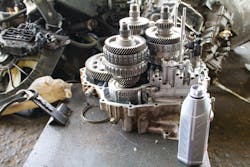When it comes to transmission failure on light duty vehicles, there are several options. Among them: repair the transmission, rebuilt it, replace it with a used one or go with a remanufactured unit.
To make an educated decision, it is necessary to understand these solutions and what is best for your situation.
Like other remanufactured components, a reman’d transmission is a smart price-point alternative for vehicle operations of all sizes and types given the current market economic conditions. A remanufactured component is ideal for those who want performance, service life and warranty support without the costs associated with a new component.
WHAT HAS BEEN DONE
A remanufactured transmission differs from a rebuilt or repaired transmission in that the unit is completely disassembled, cleaned and inspected, and any worn components are replaced, explains Mark Pelkey, industry manufacturing veteran and general manager of the light duty transmission remanufacturing business for TransAxle. The transmission is then reassembled to the same quality tolerances as the original.
“The result is an exact fit, with no modifications necessary for vehicle installation,” he adds. “The transmission is designed and tested to match the performance and fit of the original at a lower cost than a completely new unit.”
TransAxle (www.transaxle.com) is a major national remanufacturer of auto and truck components. It is the largest East Coast provider of remanufactured drivetrain components to the commercial light and heavy duty fleet and industrial markets, producing 150 to 250 light duty remanufactured transmissions every month, and more than 8,000 heavy duty transmissions annually.
Pelkey notes that within the transmission market, more than 95 percent of all replacements are not truly “new.” New transmissions are typically kept for new vehicle production.
PRICE AND QUALITY
But, as with any vehicle component, you get what you pay for when it comes to a remanufactured transmission.
“Make no mistake, all remanufactured components are not the same,” says Pelkey. “You can come across running ‘take outs,’ sometimes referred to as remanufactured. On such units, not a single component will be verified nor inspected for critical dimensional and wear criteria.”
Running take outs are also referred to as “spray and pray” products, he adds. These are transmissions that are just cleaned and painted to look new, with the hope that it still functions properly.
Pelkey says it is “imperative” to understand that a truly remanufactured transmission is one that has been completely disassembled, with each part inspected and qualified (only validated recovery processes are used); all mandatory replacement parts are changed out; the proper re-assembly process was used (built to a precise set of directions ensuring each unit is built the same way, every time); and exhaustive testing was done.
“Otherwise, the end result is a working replacement part that’s lower priced for purchase. It will get the operator and his vehicle on their way, but with no guarantees about quality or performance.”
KNOW WHO YOU DEAL WITH
“Earned trust, quality parts and experienced technicians are the key differentiators in selecting and working with a reputable transmission remanufacturer,” says Pelkey. “It is all about the delivering of quality processes, speedy availability, strong warranty and service and support after the sale.”
TransAxle light duty transmissions carry a three-year/100,000 mile warranty.
Regardless of the transmission repair option, always deal with a reputable company, he advises. Insist on personal service, knowledge of the product portfolio and a willingness to supply the right product every single time.
Transmission repair possibilities
There are a variety of options when it comes to transmission repair. As you would expect, each has an advantage and disadvantage, including price differences and quality.
Rebuilt - This is a transmission that has been disassembled and inspected, worn or damaged parts are replaced and then reassembled to factory specifications, along with new gaskets, seals, clutches, bands, etc. This is generally done in a shop where the transmission is removed from the vehicle, rebuilt and then reinstalled.
Rebuilt transmissions are also referred to as “reconditioned,” “refurbished” and “overhauled.”
Remanufactured - This is a transmission that goes to a unique factory operation where standard production methods are used to disassemble, inspect, clean and resurface or replace damaged parts and then is reassembled using new gaskets, clutches, etc.
Remanufactured transmissions, often referred to as “manufactured again,” also will include all the factory updates and often come with a longer warranty than an in-house rebuilt transmission comes with.
Repaired - This is a transmission that has had a specific component replaced or fixed.
Used - A used transmission is one that has been taken from a used vehicle. These are also known as “salvage” transmissions.
New - New transmissions are not available for service work as they are usually only used in the production of new vehicles.
About the Author

